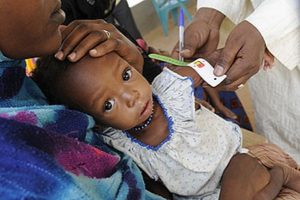The Sahel crisis continues
As does the risk of a mass polio outbreak

28 March 2013 – The harvest has come and gone but the Sahel region of west and central Africa remains in crisis. OCHA estimates that more than 10 million people will remain food insecure throughout 2013, including 1.4 million children under five suffering from acute malnutrition. At the same time, insecurity in Mali is pushing people to flee their homes and their country; and for those that remain (particularly in the North), the price of food is rapidly rising.
In the midst of this crisis are the polio-affected countries of Chad, Niger and Nigeria. Niger, which saw a case of polio in November last year, is not only affected by the crisis itself, but has thousands of refugees crossing its borders from neighbouring Mali. In this region that forms part of what is known as the “wild poliovirus importation belt” – because it has been repeatedly reinfected with polio – mass population movement, malnutrition and refugee camp conditions are creating the perfect opportunity for communicable diseases like polio to spread. And with vaccination rounds scaled back in 2012 due to a funding shortfall, too many children remain vulnerable to this disease.
There is hope, however. Aid agencies are working together to provide a more holistic approach to the crisis, assisting the countries of the Sahel region to become more resilient to future droughts and food shortages. On top of providing food aid, agencies are providing agricultural assistance and, importantly, delivering water, sanitation and health services as well.
Part of this approach is to ensure that children in refugee camps receive the protection of vaccines. So the oral polio vaccine is being delivered alongside vaccines protecting against TB, hepatitis B, tetanus toxoid, pertussis (whooping cough) and other diseases. And as new camps arise, sometimes completely spontaneously, health workers are getting there as soon as they can to ensure the residents receive the vaccines’ protection. The camp of Ingui, in western Niger, for example, popped up just a week after the insecurity in Mali began. Yet it didn’t take health workers long to visit the camp, giving 163 children their two drops of polio vaccine.
Ultimately, these children should receive the polio vaccine either through routine immunization services or, if that’s not possible, during mass vaccination rounds. But last year a lack of funds meant some of those rounds didn’t happen. And while the world is currently seeing the fewest cases of polio in history, the hard work of the past 25 years could all be undone by another mass outbreak. Only so many vaccination rounds can be cancelled due to a lack of funds before polio resurges once more. That is why the Global Polio Eradication Initiative and its partners are calling on the global community to come together to fund the soon-to-be-released Polio Eradication and Endgame Strategic Plan 2013-2018 upfront. Global polio eradication efforts are too close to success to let the whole project fail now.













